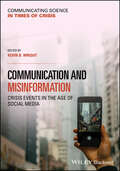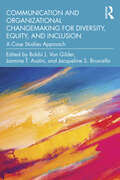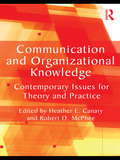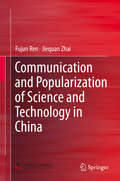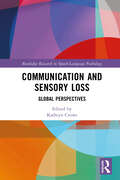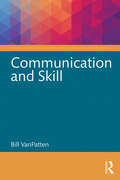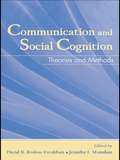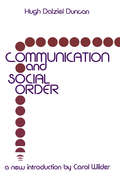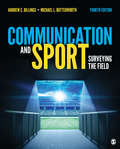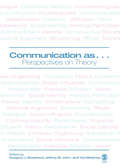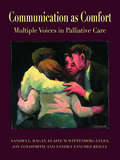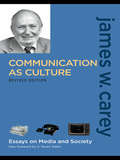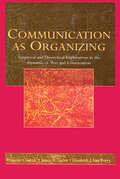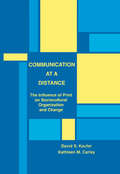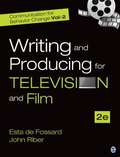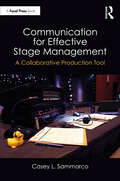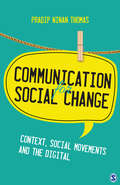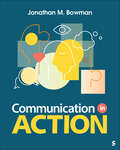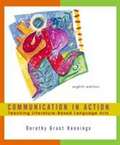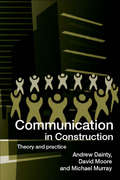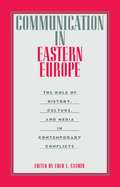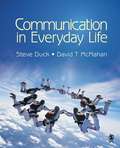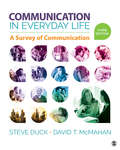- Table View
- List View
Communication and Misinformation: Crisis Events in the Age of Social Media (Communicating Science in Times of Crisis)
by Kevin B. WrightExploring the influence misinformation has on public perceptions of the risk and severity of crisis events To what extent can social media networks reduce risks to the public during times of crisis? How do theoretical frameworks help researchers understand the spread of misinformation? Which research tools can identify and track misinformation about crisis events on social media? What approaches may persuade those resistant to changing their perceptions of crisis events? Communication and Misinformation presents cutting-edge research on the development, spread, and impact of online misinformation during crisis events. Edited by a leading scholar in the field, this timely and authoritative volume brings together a team of expert contributors to explore the both the practical aspects and research implications of the public’s reliance on social media to obtain information in times of crisis. Throughout the book, detailed chapters examine the increasingly critical role of risk and health communication, underscore the importance of identifying and analyzing the dissemination and impact of misinformation, provide strategies for correcting misinformation with science-based explanations for causes of crisis events, and more. Addressing multiple contexts and perspectives, including political communication, reputational management, and social network theory, Communication and Misinformation: Crisis Events in the Age of Social Media is an essential resource for advanced undergraduate and graduate students, instructors, scholars, and public- and private-sector professionals in risk and crisis communication, strategic communication, public relations, and media studies.
Communication and Organizational Changemaking for Diversity, Equity, and Inclusion: A Case Studies Approach
by Van Gilder, Bobbi J. Jasmine T. Austin Jacqueline S. BruscellaThis book explores the opportunities, challenges, and effective approaches to organizational change regarding diversity, equity, inclusion, and belonging. Featuring application-based case studies and practical guidelines for meaningful organizational change, this book problematizes some of the current DEI initiatives in today’s organizations. It examines multiple forms of diversity (e.g., race, age, and mental health) from a variety of perspectives (e.g., leadership and employee), with case studies that demonstrate how changemaking efforts can be reimagined and implemented in better, more nuanced, and more sustainable ways to produce meaningful organizational change. Through these case studies, readers learn from organizations’ successes and failures in their attempts to implement DEI practices. Each chapter concludes with explicit practical implications and/or actionable recommendations for organizational changemaking. This text will make an impactful addition to courses in communication and diversity or organizational communication/change at the advanced undergraduate or graduate level, and will be an essential guide for professionals wishing to lead change in their organizations.
Communication and Organizational Knowledge: Contemporary Issues for Theory and Practice (Routledge Communication Series)
by Heather E. CanaryThis book provides an overview of communication-centered theory and research regarding organizational knowledge and learning. It brings the work of scholars in communication, management, information technology, and other disciplines together in a coherent volume that represents existing research and theory on communication-related knowledge work. Chapters address what constitutes knowledge, how knowledge functions within and across organizations, and how organizational members develop and manage knowledge for organizational purposes. The book also provides a forum for these scholars to pose directions for future research and theorizing. It will serve as a reference tool for scholars and practitioners to identify and understand communicative features of organizational knowledge processes.
Communication and Popularization of Science and Technology in China
by Fujun Ren Jiequan ZhaiThis book aims to be a reference for researchers studying the promotion of scientific literacy in China, as well as a guide for those interested in promoting scientific awareness. It covers advances in science and technology, communication and popularization practice, and research (STCP) both in China and abroad. Theoretical issues are discussed, and important problems in promoting scientific and technological awareness are identified (e. g. : basic principles, structures, channels of communication and current needs) This bookprovides a summary of the advances in STCP in China in recent years (especially after the issuing of the "National Scientific Literacy Outline") including STCP resource and capacity building, science popularization policies, practitioner development, infrastructure construction, and the development of the science popularization industry as a whole. At the same time, this book also reviews thedesign, organization, monitoring and evaluation of science and technology communication and popularization programs. It also highlights current STCP trends and developments in China and calls for a greater emphasis to be placed on research into promoting scientific literacy. It is hoped that this book will be useful to readers both in China and abroad by familiarizing them with the history and theory of STCP as well as its development over time. The 1st chapter briefly reviews the history of STCP. The 2nd through 5th chapters discuss the conceptual framework, basic structure, methods of communication, and current STCP needs. The 6th chapter introduces the principle content of programs aimed at improving Chinese citizens' scientific literacy, while the 7th and 8th chapters analyze the resources, capacities and conditions that have been developed for STCP in China. The 9th chapter investigates the organization, monitoring and evaluation of science popularization practices, and the final chapter summarizes important STCP topics and trends in contemporary China.
Communication and Sensory Loss: Global Perspectives (Routledge Research in Speech-Language Pathology)
by Kathryn CroweThis collection explores communication differences in individuals with sensory impairment/loss relevant to health and education students and professionals.Children and adults with hearing, vision, and dual sensory impairment/ loss may experience differences and/or difficulties with communication. This book goes beyond describing sensory loss to encourage readers to think about sensory loss and communication as part of a biopsychosocial view of health and the intersecting identities of the clients and families that they service. The book takes a strengths-based, evidence-informed approach and utilises the International Classification of Functioning, Disability and Health (ICF) of the World Health Organization (WHO). Each chapter focuses on either children or adults with hearing, vision, dual sensory impairment/loss, or sensory loss and complex communication needs. Each chapter introduces the group described in the chapter and issues around appropriate use of terminology, followed by a discussion of the sensory impairment/loss and communication needs considered within each component of the ICF. Chapters conclude with case studies highlighting cultural and linguistic diversity, high-resourced and low- resourced contexts, and intersecting identities in which the framework of the ICF is applied.This book is a valuable resource for scholars, educators, and clinicians interested in evidence-based practices to support their work with individuals experiencing sensory loss.
Communication and Skill (The Routledge E-Modules on Contemporary Language Teaching)
by Bill VanPattenIn this module on communication, the reader explores the nature and consequences of a particular definition of communication: the expression and interpretation of meaning in a given context. Special attention is given to context (i.e., physical setting, participants, purpose of communication) and how these impact how we think about communication in language classrooms. Please visit the series companion website for more information: http://routledgetextbooks.com/textbooks/9781315679594/
Communication and Social Cognition: Theories and Methods (Routledge Communication Series)
by David R. Roskos-Ewoldsen Jennifer L. MonahanCommunication and Social Cognition represents the explosion of work in the field of social cognition over the past 25 years. Expanding the contribution made by Social Cognition and Communication, published in 1982, this scholarly collection updates the study of communication from a social cognitive perspective, with contributions from well-known experts and promising new scholars in diverse areas of communication. Organized into sections--message production, interpersonal communication, media, and social influence--the collection reflects the areas in which social cognition theories have become integral in understanding communicative processes, and in which a proliferation of scholarship has emerged. Readers are informed of the current major trends in social cognition research, and are introduced to its history. Throughout the text, chapter authors highlight both theoretical and methodological aspects of research, encouraging communication scholars to include social cognition in their research, and, likewise, promoting communication to social cognition researchers. The volume addresses the future of social cognition, including the most fitting directions in which to take scholarship, emerging theories in the field, and the methods currently yielding the most promising results. Communication and Social Cognition appeals to scholars, researchers, and advanced students in communication and psychology. It can be used as a textbook in graduate courses related to social cognition, social influence, message production, interpersonal communication, media effects, and message design.
Communication and Social Order
by Hugh Dalziel DuncanIn this highly influential study of art forms as models for a theory of communications, Hugh Dalziel Duncan demonstrates that without understanding of the role of symbols in society, social scientists cannot hope to develop adequate models for social analysis. He reviews critically major contributions to communication theory during the past century: Freud's analysis of dream symbolism, Simmel's concept of sociability, James' insights into religious experience, and Dewey's relating of art to experience.
Communication and Sport: Surveying the Field
by Andrew C. Billings Michael L. ButterworthCommunication and Sport: Surveying the Field provides students with an understanding of sports media, rhetoric, culture, and organizations through an examination of a wide range of topics. Authors Andrew C. Billings and Michael L. Butterworth address everything from youth to amateur to professional sports through varied lenses, including mythology, community, and identity. A comprehensive focus on communication scholarship gives attention to the ways that sports produce, maintain, or resist cultural attitudes about race, gender, sexuality, class, and politics. The Fourth Edition includes new interviews with prominent figures in the field and new discussions on current events like the Black Lives Matter movement and the COVID-19 pandemic.
Communication and Sport: Surveying the Field
by Andrew C. Billings Michael L. ButterworthCommunication and Sport: Surveying the Field provides students with an understanding of sports media, rhetoric, culture, and organizations through an examination of a wide range of topics. Authors Andrew C. Billings and Michael L. Butterworth address everything from youth to amateur to professional sports through varied lenses, including mythology, community, and identity. A comprehensive focus on communication scholarship gives attention to the ways that sports produce, maintain, or resist cultural attitudes about race, gender, sexuality, class, and politics. The Fourth Edition includes new interviews with prominent figures in the field and new discussions on current events like the Black Lives Matter movement and the COVID-19 pandemic.
Communication as ...: Perspectives on Theory
by Ted Striphas Dean Gregory J. Shepherd Professor Jeffrey St. JohnIn Communication as...: Perspectives on Theory, editors Gregory J. Shepherd, Jeffrey St. John, and Ted Striphas bring together a collection of 27 essays that explores the wide range of theorizing about communication, cutting across all lines of traditional division in the field. The essays in this text are written by leading scholars in the field of communication theory, with each scholar employing a particular stance or perspective on what communication theory is and how it functions. In essays that are brief, argumentative, and forceful, the scholars propose their perspective as a primary or essential way of viewing communication with decided benefits over other views.
Communication as Comfort: Multiple Voices in Palliative Care (Routledge Communication Series)
by Sandra L. Ragan Elaine M. Wittenberg-Lyles Joy Goldsmith Sandra Sanchez ReillyThis exceptional work explores the complexities of communication at one of the most critical stages of the life experience--during advanced, serious illness and at the end of life. Challenging the predominantly biomedical model that informs much communication between seriously ill and/or dying patients and their physicians, caregivers, and families, Sandra L. Ragan, Elaine M. Wittenberg-Lyles, Joy Goldsmith, and Sandra Sanchez-Reilly pose palliative care--medical care designed to comfort rather than to cure patients--as an antidote to the experience of most Americans at the most vulnerable juncture of their lives. With an author team comprised of three health communication scholars and one physician certified in geriatrics and palliative medicine, this volume integrates the medical literature on palliative care with that of health communication researchers who advocate a biopsychosocial approach to health care. Applying communication theories and insights to illuminate problems and to explain their complexities, the authors advocate a patient-centered approach to care that recognizes and seeks to lessen patients’ suffering and the many types of pain they may experience (physical, psychological, social, and spiritual) during life-threatening illness.
Communication as Culture, Revised Edition: Essays on Media and Society
by James W. CareyIn this classic text, James W. Carey maintains that communication is not merely the transmission of information; reminding the reader of the link between the words "communication" and "community," he broadens his definition to include the drawing-together of a people that is culture. In this context, Carey questions the American tradition of focusing only on mass communication's function as a means of social and political control, and makes a case for examining the content of a communication—the meaning of symbols, not only the motives that originate them or the purposes they serve. He seeks to recast the goal of communication studies, replacing the search for deterministic laws of behavior with a simpler, yet far more challenging mission: "to enlarge the human conversation by comprehending what others are saying." This new edition includes a new critical foreword by G. Stuart Adam that explains Carey's fundamental role in transforming the study of mass communication to include a cultural perspective and connects his classic essays with contemporary media issues and trends. This edition also adds a new, complete bibliography of all of Carey's writings.
Communication as Organizing: Empirical and Theoretical Explorations in the Dynamic of Text and Conversation (Routledge Communication Series)
by James R. Taylor Elizabeth J. Van Every François CoorenCommunication as Organizing unites multiple reflections on the role of language under a single rubric: the organizing role of communication. Stemming from Jim Taylor's earlier work, The Emergent Organization: Communication as Its Site and Surface (LEA, 2000), the volume editors present a communicational answer to the question, "what is an organization?" through contributions from an international set of scholars and researchers. The chapter authors synthesize various lines of research on constituting organizations through communication, describing their explorations of the relation between language, human practice, and the constitution of organizational forms. Each chapter develops a dimension of the central theme, showing how such concepts as agency, identity, sensemaking, narrative and account may be put to work in discursive analysis to develop effective research into organizing processes. The contributions employ concrete examples to show how the theoretical concepts can be employed to develop effective research. This distinctive volume encourages readers to discover and develop a truly communicational means of addressing the question of organization, addressing how organization itself emerges in the course of communicational transactions. In presenting a single and entirely communicational perspective for exploring organizational phenomena, grounded in the discourse of communicational transactions and the establishment of relationships through language, it is required reading for scholars, researchers, and graduate students working in organizational communication, management, social psychology, pragmatics of language, and organizational studies.
Communication at A Distance: The Influence of Print on Sociocultural Organization and Change (Routledge Communication Series)
by Kathleen M. Carley David S. KauferThis book bridges an important gap between two major approaches to mass communication -- historical and social scientific. To do so, it employs a theory of communication that unifies social, cultural and technological concerns into a systematic and formal framework that is then used to examine the impact of print within the larger socio-cultural context and across multiple historical contexts. The authors integrate historical studies and more abstract formal representations, achieving a set of logically coherent and well-delimited hypotheses that invite further exploration, both historically and experimentally. A second gap that the book addresses is in the area of formal models of communication and diffusion. Such models typically assume a homogeneous population and a communication whose message is abstracted from the complexities of language processing. In contrast, the model presented in this book treats the population as heterogeneous and communications as potentially variable in their content as they move across speakers or readers. Written to address and overcome many of the disciplinary divisions that have prevented the study of print from being approached from the perspective of a unified theory, this book employs a focused interdisciplinary position that encompasses several domains. It shows the underlying compatibility between cognitive and social theory; between the study of language and cognition and the study of technology; between the postmodern interest in the instability of meaning and the social science interest in the diffusion of information; between the effects of technology and issues of cultural homogeneity and heterogeneity. Overall, this book reveals how small, relatively non-interactive, disciplinary-specific conversations about print are usefully conceived of as part of a larger interdisciplinary inquiry.
Communication for Behavior Change
by Esta De Fossard John RiberThe book demonstrates how to create TV and FILM DRAMAS that encourage people to make positive behavioral changes to improve their lives. The book teaches people how to: * Create SERIAL OR STAND-ALONE DRAMAS that will appeal to a select audience * Create characters that represent and attract the target audience * Introduce subtle and convincing ways to improve the standard of living of the audience * Conduct design workshops for preparing design documents that help script writers create 'convincing' dramas containing the behavior-change message accurately
Communication for Effective Stage Management: A Collaborative Production Tool
by Casey L. SammarcoCommunication for Effective Stage Management: A Collaborative Production Tool provides a comprehensive examination of communication theory through the lens of effective stage management and offers ideas and methods for stage managers to enhance their communicative presence throughout a theatrical process.This book offers new, extensive in-depth discussion of communication techniques and how these methods apply to the role of the theatrical stage manager as the facilitator of information. Part I dives into the methods and principles of business communication employed by stage managers and discusses how these techniques are best implemented throughout a theatrical process, all supported with real-life examples. It also offers discussion questions and resources to enhance the content and encourages the reader to self-analyze their own communication techniques during the production process. Part II contains excerpts from other industry professionals who offer their own unique perspective as to the collaborative and communicative work of stage managers and how their own artistic careers are impacted by the communication systems of a stage management team.This book is best suited for advanced stage management students, professional theatre practitioners, and theatrical educators.
Communication for Social Change: Context, Social Movements and the Digital
by Pradip Ninan ThomasCommunication for Social Change: Context, Social Movements and the Digital is a critical introduction to communication for social change (CSC) theory. The book presents refreshingly new perspectives and specifically makes the case for CSC theory to factor in context, leanings from social movements and a critique of the digital technology. This book offers perspectives on the historical continuities within this field of study along with the departures that have been hastened and shaped by confluences between ideas and practice as well as by digital technology and social movements. It introduces readers to a raft of new theorists of CSC and puts forth new thinking, new ideas, and a new basis for theorisation of communication for social change.
Communication in Action
by Jonathan Michael BowmanThrough a narrative, practical approach enriched with inclusive examples, Communication in Action inspires students to think critically about the role of effective communication in driving meaningful change within their own lives and communities. Author Jonathan Bowman empowers students to apply fundamental communication principles in daily life, fostering self-awareness and an understanding of diverse perspectives. Each chapter includes activities that motivate students to engage with their online and in-person social networks, practicing effective communication for personal and professional growth. Bowman also challenges students to confront issues of power, privilege, and social justice by encouraging them to take impactful actions—whether through direct interaction or civic involvement and engagement. With engaging discussions of core concepts and contemporary examples, this text not only encourages students to explore how effective communication can drive change in their lives but also inspires a new wave of communicators committed to fostering community well-being.
Communication in Action
by Jonathan Michael BowmanThrough a narrative, practical approach enriched with inclusive examples, Communication in Action inspires students to think critically about the role of effective communication in driving meaningful change within their own lives and communities. Author Jonathan Bowman empowers students to apply fundamental communication principles in daily life, fostering self-awareness and an understanding of diverse perspectives. Each chapter includes activities that motivate students to engage with their online and in-person social networks, practicing effective communication for personal and professional growth. Bowman also challenges students to confront issues of power, privilege, and social justice by encouraging them to take impactful actions—whether through direct interaction or civic involvement and engagement. With engaging discussions of core concepts and contemporary examples, this text not only encourages students to explore how effective communication can drive change in their lives but also inspires a new wave of communicators committed to fostering community well-being.
Communication in Action: Teaching Literature-Based Language Arts (Eighth Edition)
by Dorothy HenningsCommunication in Action integrates the language arts--speaking, listening, viewing, reading, and writing--into a total curriculum that centers around children's literature. The text includes ideas for using literature to teach language skills across the curriculum, and a planning resource handbook at the end of the text that helps teachers create lesson plans, select children's books, and evaluate software options.
Communication in Construction: Theory and Practice
by Michael Murray David Moore Andrew DaintyCommunication within project-based environments presents special challenges. This is especially true within the construction industry, where interaction tends to be characterised by unfamiliar groups of people coming together for short periods before disbanding to work on other endeavours. This book examines communication at a number of levels ranging from interpersonal interactions between project participants to corporate communication between organizations. Several non-typical perspectives on the process of communication are introduced to encourage the reader to think about communication in a more innovative manner. The combination of differing perspectives illustrates the diversity of communication problems facing those working within project-based environments. Practical guidance is provided on possible solutions to communication problems, and a number of examples and case studies are presented.
Communication in Eastern Europe: The Role of History, Culture, and Media in Contemporary Conflicts (Routledge Communication Series)
by Fred L. CasmirThis volume represents a clear attempt to learn something from the events in Eastern European countries. It does not start with simplistic or old assumptions based on convenient Western communication models, but instead takes a new approach. If chaos theory could fundamentally change how physicists looked at order in the universe, then it may be of value for communication scholars to attempt to understand the diversity of chaos or order in the human universe, rather than attempt to force existing models on it for their own explanatory purposes. This book is not merely based on the study of select groups of university students or on laboratory settings created in the minds of social scientists. It seeks to understand some of the "real world," including the historical backgrounds and the theoretical assumptions brought to studies of intercultural conflicts. Using personal and professional insights developed during firsthand contacts with existing situations, chapter authors illustrate some of the realities by using the complexity of changes in Eastern European states during the final decade of the 20th century. From education to business, from the role of women to the role of mass media, from the impact of political systems to the impact of history, communication between those who are culturally diverse, though they may have been arbitrarily forced to live under the same "political roof," is the theme of these scholarly studies. The editor's reason for developing this volume of original essays is his belief that diversity rather than assumed similarity or even sameness -- based on the use of inadequate terminology -- is necessary for learning from contemporary human experiences. He further believes that diversity and the significant roles of cultural values as well as of history need to become key concepts in the model with which to begin when it comes to the study of various aspects of intercultural communication. It is therefore vital that scholars who represent various points of view and backgrounds contribute to that process. After all, understanding what is happening in the world is centrally anchored in or related to effective and successful "intercultural" communication between scholars who have different academic and personal backgrounds.
Communication in Everyday Life
by Steve Duck David T. McmahanCommunication in Everyday Life is the first survey of communication textbook to explore fundamental communication concepts, theories, skills, and contexts with a thematic integration-the relational perspective-to everyday life that allows all of these things to cohere.
Communication in Everyday Life: A Survey of Communication
by Steve Duck David T. McMahanExplore fundamental communication concepts, theories, and skills aimed at helping students apply communication skills to their personal and professional lives—with a thematic integration of the relational perspective and a focus on demonstrating its direct relevance to their own everyday communication.
